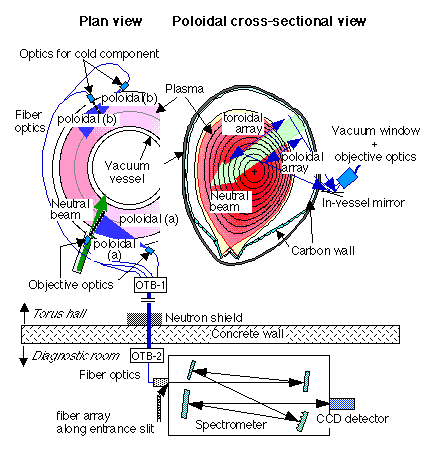Objectives
Measurement of ion temperature, toroidal & poloidal rotation velocities and impurity density.
Principle
Neutral atom (H0) and impurity ion (Aq+) undergo a charge transfer that leaves the product ion in an excited state.
H0 + Aq+ --> H+ + [A(q-1)+]*
In usual JT-60U discharges, the source of neutral atom is a neutral beam for the plasma heating, and the reaction with C6+ is used for this measurement. This is because carbon is one of intrinsic impurities and they are fully stripped throughout the plasma volume. Emissions are excited at wavelengths long enough for making accurate Doppler broadening and shift measurements.
Diagnostic Method
One of heating beams NB #14 is used for this measurement (see figures). Due to the above reaction, carbon ions near the neutral beam emit green light (529.2 nm at n=8-7 transition). The light is collected by a quartz lens onto fiber optics and is transmitted to spectrometers in the diagnostic room; then the spectrum is detected by an intensified CCD cameras for the subsequent analysis of Doppler broadening (--> temperature), Doppler shift (--> rotation velocity) and its area (--> impurity density). According to the ionization balance, there are C5+ ions in the edge region, which can emit at the same transition due to direct excitation by electrons (not by neutral beams). Therefore it is important to separate the spectrum by beam excitation from that by electron excitation. In order for this, CXRS system in JT-60U has an exclusive optics for the background spectrum.
Specifications
| Number of channels | toroidal : 23 | poloidal : 36 |
| Spatial resolution | toroidal : 5 cm | poloidal : 0.8/1.5 cm |
| Time resolution | 16.7 ms |

Reference
Y. Koide, A. Sakasai, Y. Sakamoto, H. Kubo and T. Sugie, Rev. Sci. Instrum. 72, 119 (2001)

